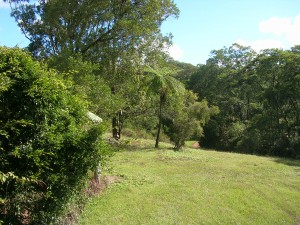The weather is perfect today 10-20C and sparkling blue sky. A perfect winters day. The rainforest residents like it too and are most active. A little while ago there was a little white-browed scrub wren in the house and it perched on my hand for a while before flying out. The platypus have been active, the possums cheeky, and the wallabies hopping. The social life of the animals perks up noticeably in the fine weather. If you don’t know birds and animals have a social life, you haven’t been paying attention. I have seen love affairs, tender child rearing, home building, hideous fights, fornication in my lounge room, gang turf wars, bullying, gender identity issues, inter-species cooperation and wars and all manner of behaviour you would find in …… well …. your average soap opera. I am in no doubt that birds and animals feel the same emotions as us and at a similar intensity. Far from being perfectly adapted to their environment and knowing precisely what to do, they make blunders and have much to learn.
As an example of complex behaviour I hadn’t guessed at, one day I was attracted by a huge racket from birds up the hill. It turned out to be a flock of about 70 currawongs and about the same number of crimson rosellas and they were having a scrap. One lot in one tree and the other lot in another screaming abuse at each other (my interpretation). Every now and then 5-10 birds would fly out of their tree to a tird tree about in the middle, Soon after they would be matched by the same number from the rival gang. I couldn’t see much of what went on, but there was much noise and they were being cheered on by the partisan spectators. Then suddenly they would all return to the gang headquarters. Several times this cycle repeated and always the birds second to fly into the tree matched the number of the challenging champions. I gathered that there were rules to this stoush, and that they could count at least as well as I could in the melee. After about half an hour I left them to it. I had no idea before that bird behaviour could be so determined and complex.
Many of my recent guest have seen tree kangaroos, some by diligent and patient observation, but most by chance. Two sightings right next to Maple Cottage. Several others near the sauna.
Just a couple of hours ago I was showing newly arrived guest around and discovered one was a herpetologist. What brilliant timing! How often have you thought “there is never a herpetologist around when you need one”? You see my froggy mate Cedric, referred to and pictured in a previous blog ‘Indoor Zoo’, had reappeared in the kitchen after a two week absence. We had been shower buddies for some time and I missed him. He jumped out of the cutlery holder as I was doing the washing-up. He was very lucky I didn’t stab him with a knife. I hadn’t been able to identify him despite being given a book by the authors of “Rainforest Frogs of the Wet Tropics” who came to Possum Valley. You see I am overrun by herpetologists. Not being one to miss an opportunity, I press-ganged this scholar and gentleman into coming to identify and photograph my little friend after just an hour after arriving at what he thought might be a relaxing weekend. He came to a definite conclusion. He didn’t know what it was. He explained that the appearance of frogs varied widely. Not only that, they could change appearance to suit the environment not by evolutionary drift, but in weeks like a slow-motion chameleon. And it was only possible to tell sex (in a non-destructive way), when they were mating when it was presumed the male was on top. We know how stereotypes can be misleading. I have seen pictures of a three-high stack of frogs, which puts doubt on even that methodology. He will e-mail of his very detailed pics of Cedric to a high-ranking chief in the clan of herpetologists in the hope of receiving a pronouncement. Stay tuned to this channel for more nail-biting updates.
For the third time today nearly tripped over a black snake. As usual, it took off like I was poisonous or something. I really can’t understand their morbid fear of humans. Can’t we all get along together?


